jump start CHEVROLET IMPALA 2004 8.G Owners Manual
[x] Cancel search | Manufacturer: CHEVROLET, Model Year: 2004, Model line: IMPALA, Model: CHEVROLET IMPALA 2004 8.GPages: 420, PDF Size: 2.73 MB
Page 225 of 420
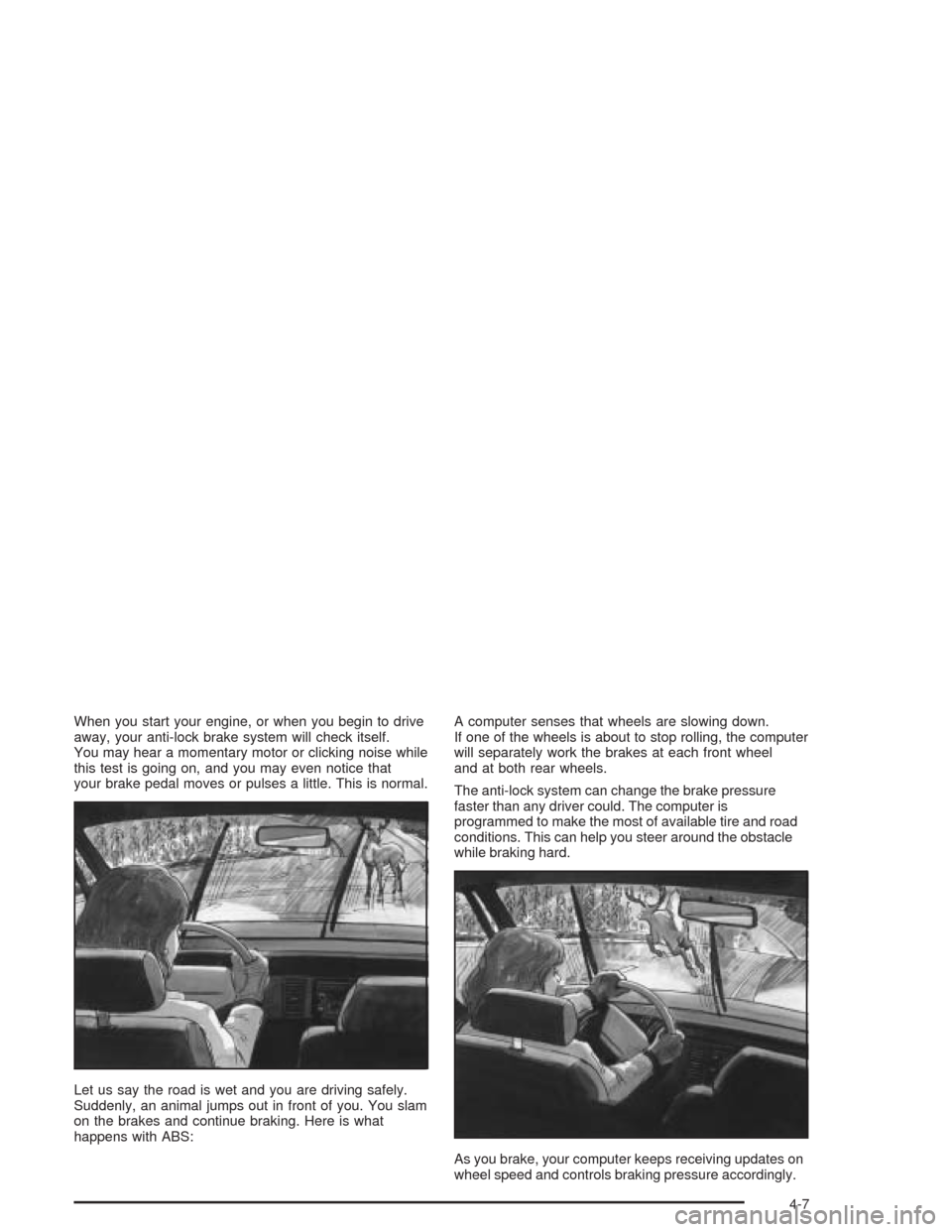
When you start your engine, or when you begin to drive
away, your anti-lock brake system will check itself.
You may hear a momentary motor or clicking noise while
this test is going on, and you may even notice that
your brake pedal moves or pulses a little. This is normal.
Let us say the road is wet and you are driving safely.
Suddenly, an animal jumps out in front of you. You slam
on the brakes and continue braking. Here is what
happens with ABS:A computer senses that wheels are slowing down.
If one of the wheels is about to stop rolling, the computer
will separately work the brakes at each front wheel
and at both rear wheels.
The anti-lock system can change the brake pressure
faster than any driver could. The computer is
programmed to make the most of available tire and road
conditions. This can help you steer around the obstacle
while braking hard.
As you brake, your computer keeps receiving updates on
wheel speed and controls braking pressure accordingly.
4-7
Page 263 of 420

Service............................................................5-3
Doing Your Own Service Work.........................5-4
Adding Equipment to the Outside
of Your Vehicle...........................................5-4
Fuel................................................................5-5
Gasoline Octane............................................5-5
Gasoline Speci�cations....................................5-5
California Fuel...............................................5-6
Additives.......................................................5-6
Fuels in Foreign Countries...............................5-7
Filling Your Tank............................................5-7
Filling a Portable Fuel Container.....................5-10
Checking Things Under
the Hood....................................................5-10
Hood Release..............................................5-11
Engine Compartment Overview.......................5-12
Engine Oil...................................................5-18
Supercharger Oil..........................................5-24
Engine Air Cleaner/Filter................................5-25
Automatic Transaxle Fluid..............................5-26
Engine Coolant.............................................5-29
Radiator Pressure Cap..................................5-32
Engine Overheating.......................................5-32Cooling System............................................5-35
Power Steering Fluid.....................................5-45
Windshield Washer Fluid................................5-46
Brakes........................................................5-47
Battery........................................................5-50
Jump Starting...............................................5-51
Headlamp Aiming...........................................5-58
Bulb Replacement..........................................5-58
Halogen Bulbs..............................................5-58
Headlamps, Front Turn Signal, and
Parking Lamps..........................................5-59
Taillamps, Turn Signal, Stoplamps and
Sidemarker Lamps.....................................5-61
Back-Up Lamps............................................5-62
Replacement Bulbs.......................................5-62
Windshield Wiper Blade Replacement..............5-63
Tires..............................................................5-64
In�ation - Tire Pressure.................................5-72
Tire Pressure Monitor System.........................5-73
Tire Inspection and Rotation...........................5-75
When It Is Time for New Tires.......................5-76
Buying New Tires.........................................5-76
Section 5 Service and Appearance Care
5-1
Page 275 of 420
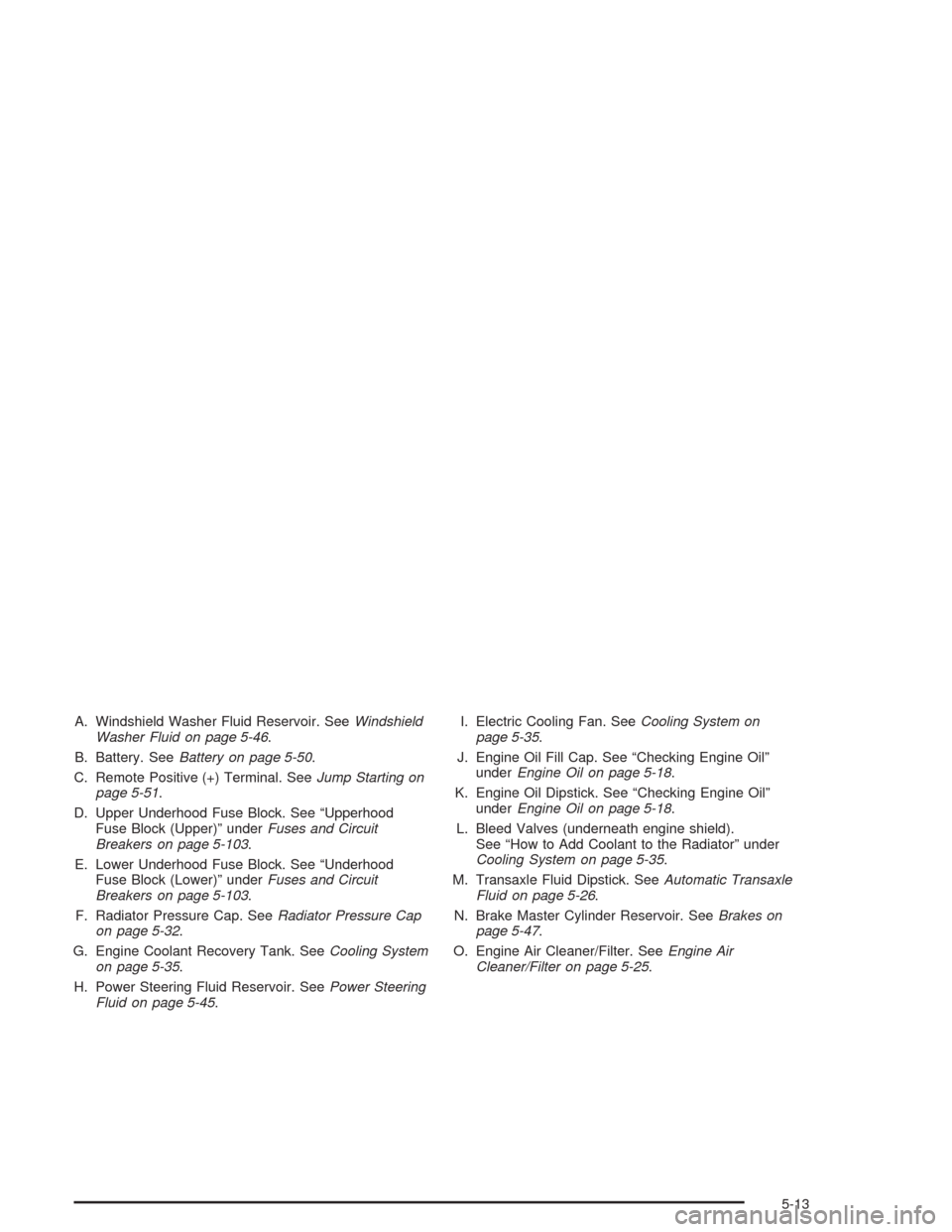
A. Windshield Washer Fluid Reservoir. SeeWindshield
Washer Fluid on page 5-46.
B. Battery. SeeBattery on page 5-50.
C. Remote Positive (+) Terminal. SeeJump Starting on
page 5-51.
D. Upper Underhood Fuse Block. See “Upperhood
Fuse Block (Upper)” underFuses and Circuit
Breakers on page 5-103.
E. Lower Underhood Fuse Block. See “Underhood
Fuse Block (Lower)” underFuses and Circuit
Breakers on page 5-103.
F. Radiator Pressure Cap. SeeRadiator Pressure Cap
on page 5-32.
G. Engine Coolant Recovery Tank. SeeCooling System
on page 5-35.
H. Power Steering Fluid Reservoir. SeePower Steering
Fluid on page 5-45.I. Electric Cooling Fan. SeeCooling System on
page 5-35.
J. Engine Oil Fill Cap. See “Checking Engine Oil”
underEngine Oil on page 5-18.
K. Engine Oil Dipstick. See “Checking Engine Oil”
underEngine Oil on page 5-18.
L. Bleed Valves (underneath engine shield).
See “How to Add Coolant to the Radiator” under
Cooling System on page 5-35.
M. Transaxle Fluid Dipstick. SeeAutomatic Transaxle
Fluid on page 5-26.
N. Brake Master Cylinder Reservoir. SeeBrakes on
page 5-47.
O. Engine Air Cleaner/Filter. SeeEngine Air
Cleaner/Filter on page 5-25.
5-13
Page 277 of 420
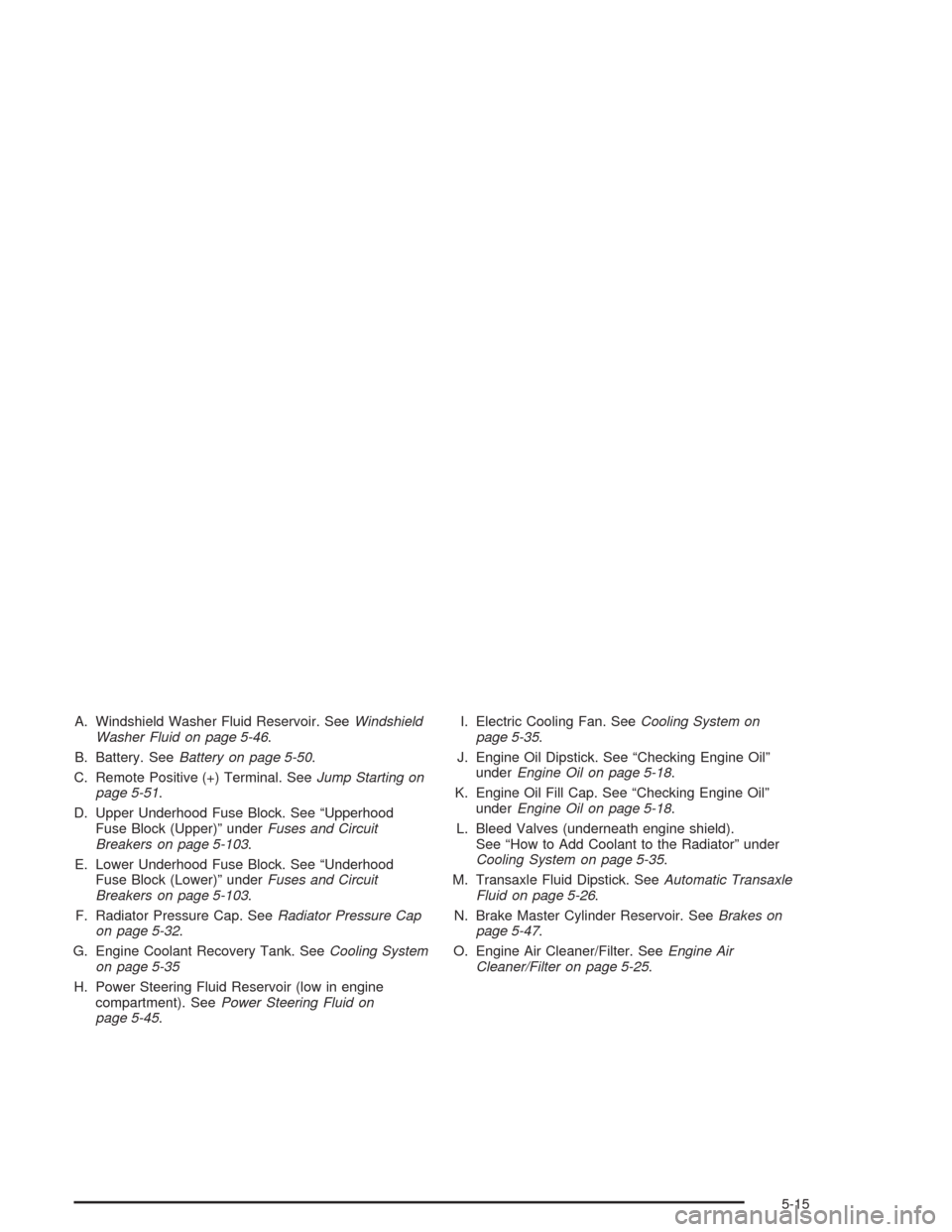
A. Windshield Washer Fluid Reservoir. SeeWindshield
Washer Fluid on page 5-46.
B. Battery. SeeBattery on page 5-50.
C. Remote Positive (+) Terminal. SeeJump Starting on
page 5-51.
D. Upper Underhood Fuse Block. See “Upperhood
Fuse Block (Upper)” underFuses and Circuit
Breakers on page 5-103.
E. Lower Underhood Fuse Block. See “Underhood
Fuse Block (Lower)” underFuses and Circuit
Breakers on page 5-103.
F. Radiator Pressure Cap. SeeRadiator Pressure Cap
on page 5-32.
G. Engine Coolant Recovery Tank. SeeCooling System
on page 5-35
H. Power Steering Fluid Reservoir (low in engine
compartment). SeePower Steering Fluid on
page 5-45.I. Electric Cooling Fan. SeeCooling System on
page 5-35.
J. Engine Oil Dipstick. See “Checking Engine Oil”
underEngine Oil on page 5-18.
K. Engine Oil Fill Cap. See “Checking Engine Oil”
underEngine Oil on page 5-18.
L. Bleed Valves (underneath engine shield).
See “How to Add Coolant to the Radiator” under
Cooling System on page 5-35.
M. Transaxle Fluid Dipstick. SeeAutomatic Transaxle
Fluid on page 5-26.
N. Brake Master Cylinder Reservoir. SeeBrakes on
page 5-47.
O. Engine Air Cleaner/Filter. SeeEngine Air
Cleaner/Filter on page 5-25.
5-15
Page 313 of 420
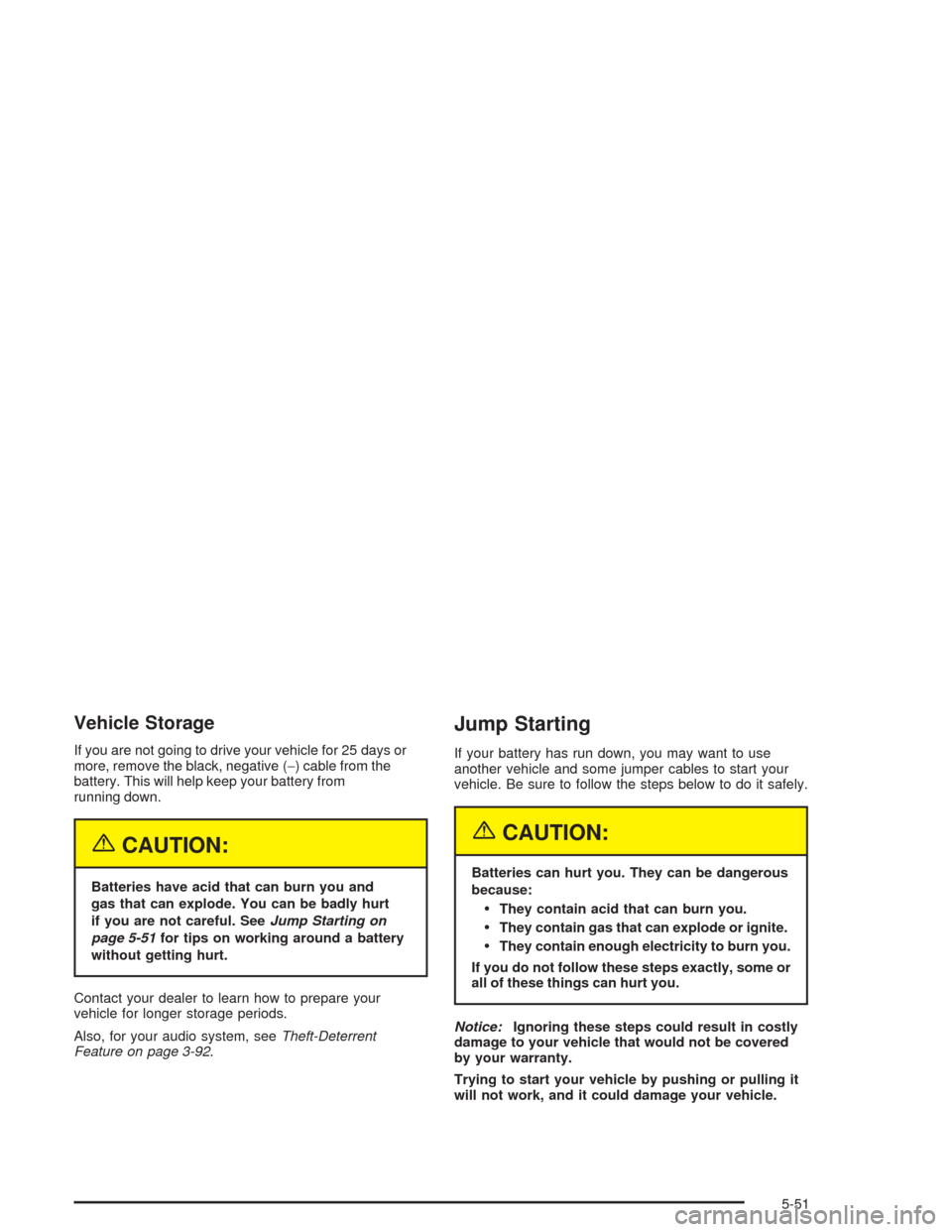
Vehicle Storage
If you are not going to drive your vehicle for 25 days or
more, remove the black, negative (−) cable from the
battery. This will help keep your battery from
running down.
{CAUTION:
Batteries have acid that can burn you and
gas that can explode. You can be badly hurt
if you are not careful. SeeJump Starting on
page 5-51for tips on working around a battery
without getting hurt.
Contact your dealer to learn how to prepare your
vehicle for longer storage periods.
Also, for your audio system, seeTheft-Deterrent
Feature on page 3-92.
Jump Starting
If your battery has run down, you may want to use
another vehicle and some jumper cables to start your
vehicle. Be sure to follow the steps below to do it safely.
{CAUTION:
Batteries can hurt you. They can be dangerous
because:
They contain acid that can burn you.
They contain gas that can explode or ignite.
They contain enough electricity to burn you.
If you do not follow these steps exactly, some or
all of these things can hurt you.
Notice:Ignoring these steps could result in costly
damage to your vehicle that would not be covered
by your warranty.
Trying to start your vehicle by pushing or pulling it
will not work, and it could damage your vehicle.
5-51
Page 314 of 420
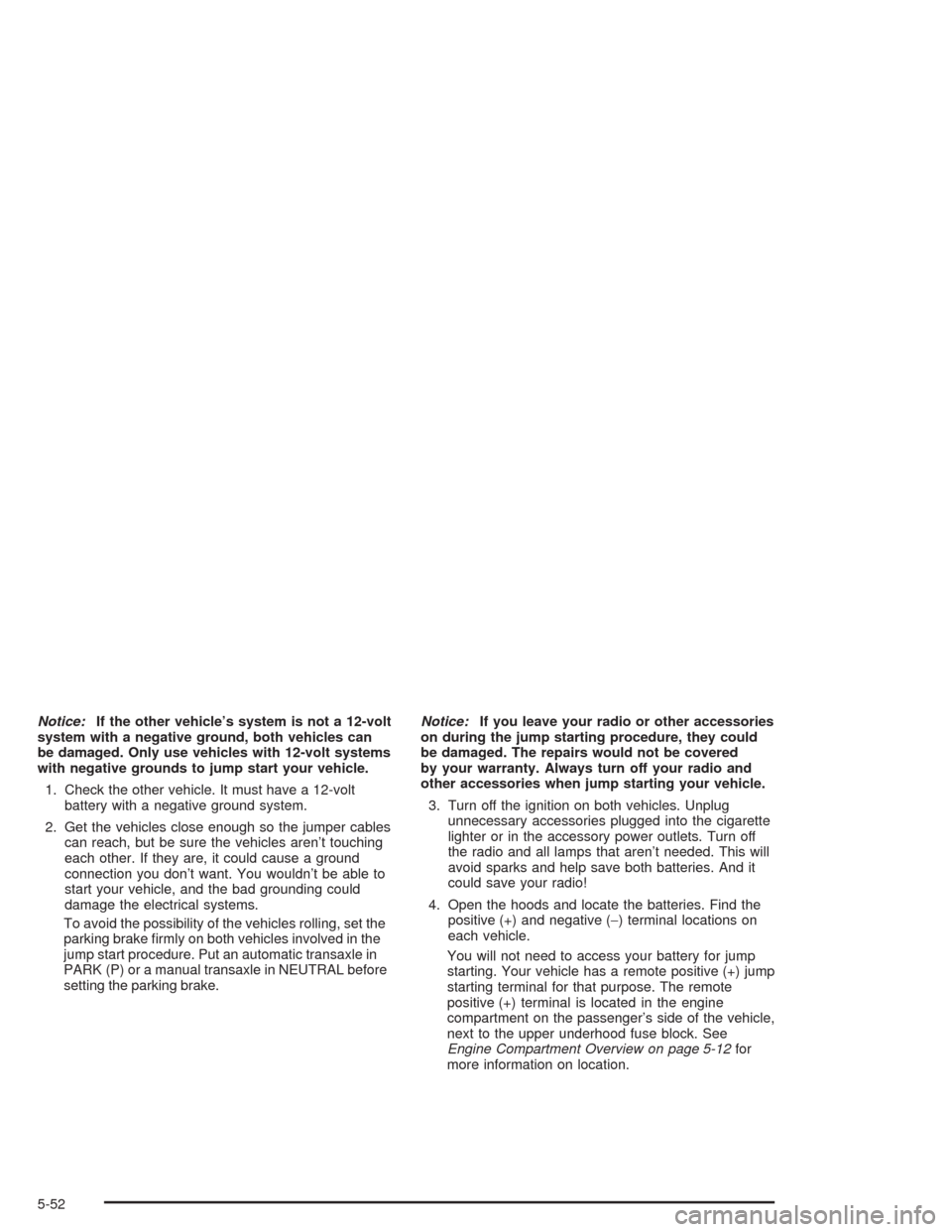
Notice:If the other vehicle’s system is not a 12-volt
system with a negative ground, both vehicles can
be damaged. Only use vehicles with 12-volt systems
with negative grounds to jump start your vehicle.
1. Check the other vehicle. It must have a 12-volt
battery with a negative ground system.
2. Get the vehicles close enough so the jumper cables
can reach, but be sure the vehicles aren’t touching
each other. If they are, it could cause a ground
connection you don’t want. You wouldn’t be able to
start your vehicle, and the bad grounding could
damage the electrical systems.
To avoid the possibility of the vehicles rolling, set the
parking brake �rmly on both vehicles involved in the
jump start procedure. Put an automatic transaxle in
PARK (P) or a manual transaxle in NEUTRAL before
setting the parking brake.Notice:If you leave your radio or other accessories
on during the jump starting procedure, they could
be damaged. The repairs would not be covered
by your warranty. Always turn off your radio and
other accessories when jump starting your vehicle.
3. Turn off the ignition on both vehicles. Unplug
unnecessary accessories plugged into the cigarette
lighter or in the accessory power outlets. Turn off
the radio and all lamps that aren’t needed. This will
avoid sparks and help save both batteries. And it
could save your radio!
4. Open the hoods and locate the batteries. Find the
positive (+) and negative (−) terminal locations on
each vehicle.
You will not need to access your battery for jump
starting. Your vehicle has a remote positive (+) jump
starting terminal for that purpose. The remote
positive (+) terminal is located in the engine
compartment on the passenger’s side of the vehicle,
next to the upper underhood fuse block. See
Engine Compartment Overview on page 5-12for
more information on location.
5-52
Page 318 of 420

9. Connect the other end of the negative (−) cable at
least 18 inches (45 cm) away from the dead battery,
but not near engine parts that move. The electrical
connection is just as good there, and the chance
of sparks getting back to the battery is much less.10. Now start the vehicle with the good battery and run
the engine for a while.
11. Try to start the vehicle that had the dead battery.
If it won’t start after a few tries, it probably needs
service.
Notice:If the jumper cables are removed in the
wrong order, electrical shorting may occur and
damage the vehicle. The repairs would not be
covered by your warranty. Remove the jumper
cables in the correct order, making sure that the
cables do not touch each other or other metal.
5-56
Page 396 of 420
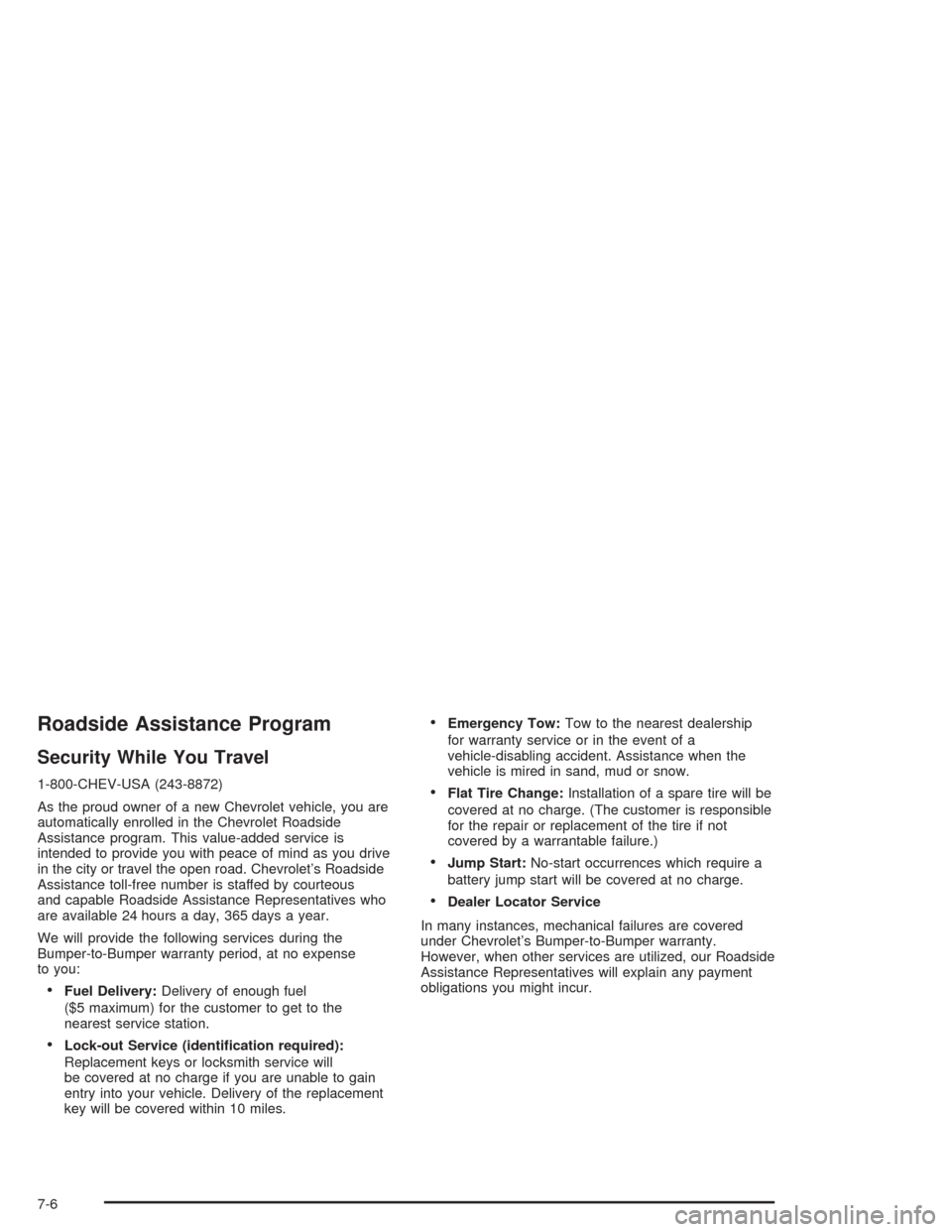
Roadside Assistance Program
Security While You Travel
1-800-CHEV-USA (243-8872)
As the proud owner of a new Chevrolet vehicle, you are
automatically enrolled in the Chevrolet Roadside
Assistance program. This value-added service is
intended to provide you with peace of mind as you drive
in the city or travel the open road. Chevrolet’s Roadside
Assistance toll-free number is staffed by courteous
and capable Roadside Assistance Representatives who
are available 24 hours a day, 365 days a year.
We will provide the following services during the
Bumper-to-Bumper warranty period, at no expense
to you:
Fuel Delivery:Delivery of enough fuel
($5 maximum) for the customer to get to the
nearest service station.
Lock-out Service (identi�cation required):
Replacement keys or locksmith service will
be covered at no charge if you are unable to gain
entry into your vehicle. Delivery of the replacement
key will be covered within 10 miles.
Emergency Tow:Tow to the nearest dealership
for warranty service or in the event of a
vehicle-disabling accident. Assistance when the
vehicle is mired in sand, mud or snow.
Flat Tire Change:Installation of a spare tire will be
covered at no charge. (The customer is responsible
for the repair or replacement of the tire if not
covered by a warrantable failure.)
Jump Start:No-start occurrences which require a
battery jump start will be covered at no charge.
Dealer Locator Service
In many instances, mechanical failures are covered
under Chevrolet’s Bumper-to-Bumper warranty.
However, when other services are utilized, our Roadside
Assistance Representatives will explain any payment
obligations you might incur.
7-6
Page 412 of 420
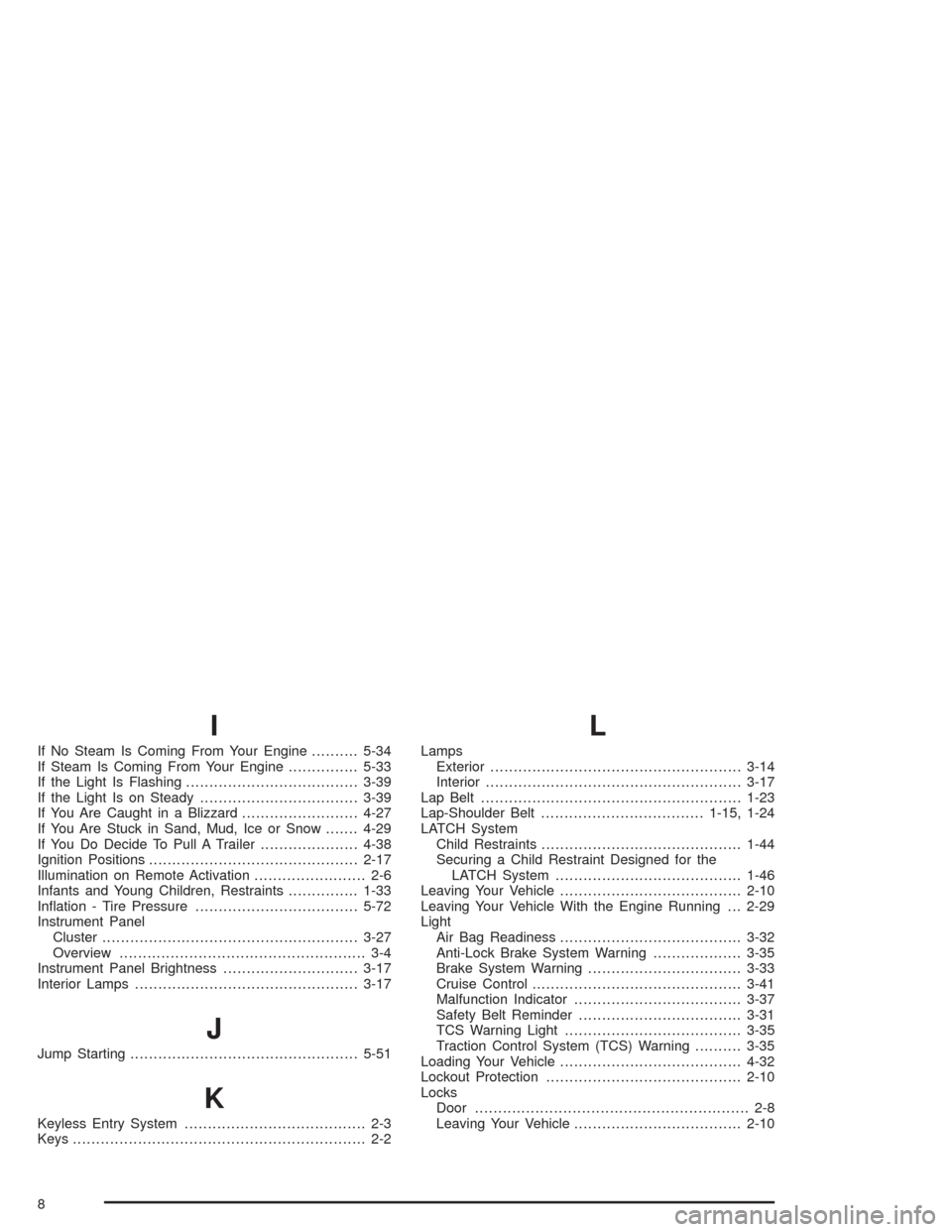
I
If No Steam Is Coming From Your Engine..........5-34
If Steam Is Coming From Your Engine...............5-33
If the Light Is Flashing.....................................3-39
If the Light Is on Steady..................................3-39
If You Are Caught in a Blizzard.........................4-27
If You Are Stuck in Sand, Mud, Ice or Snow.......4-29
If You Do Decide To Pull A Trailer.....................4-38
Ignition Positions.............................................2-17
Illumination on Remote Activation........................ 2-6
Infants and Young Children, Restraints...............1-33
In�ation - Tire Pressure...................................5-72
Instrument Panel
Cluster.......................................................3-27
Overview..................................................... 3-4
Instrument Panel Brightness.............................3-17
Interior Lamps................................................3-17
J
Jump Starting.................................................5-51
K
Keyless Entry System....................................... 2-3
Keys............................................................... 2-2
L
Lamps
Exterior......................................................3-14
Interior.......................................................3-17
Lap Belt........................................................1-23
Lap-Shoulder Belt...................................1-15, 1-24
LATCH System
Child Restraints...........................................1-44
Securing a Child Restraint Designed for the
LATCH System........................................1-46
Leaving Your Vehicle.......................................2-10
Leaving Your Vehicle With the Engine Running . . . 2-29
Light
Air Bag Readiness.......................................3-32
Anti-Lock Brake System Warning...................3-35
Brake System Warning.................................3-33
Cruise Control.............................................3-41
Malfunction Indicator....................................3-37
Safety Belt Reminder...................................3-31
TCS Warning Light......................................3-35
Traction Control System (TCS) Warning..........3-35
Loading Your Vehicle.......................................4-32
Lockout Protection..........................................2-10
Locks
Door........................................................... 2-8
Leaving Your Vehicle....................................2-10
8